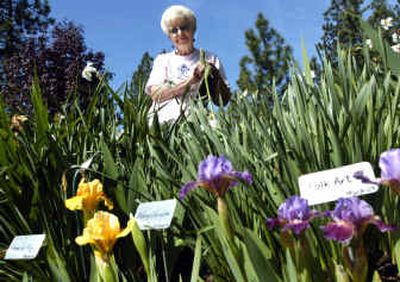Where have all the iris lovers gone?

The dandelion club has overtaken the iris society. Norma Lunden doesn’t understand why.
The flowers in her garden southwest of Mica, all 1,000 of them, are assembled like schoolchildren for a spring class photo, short ones in the front, tall ones in the back. No two are alike; each one has its own name printed on a metal placard poking from the ground.
“I see these people who have nothing but lawn and bushes and I think, ‘how boring,’ ” Lunden said.
She is talking and weeding at the same time, pulling a short tendril of corn spurry from dirt so tilled that any meandering seed can settle in. The garden is an intelligent design of undeniable order with favorites well-tended and undesirables culled. Not one footprint disturbs the earth.
If there’s a pair of soiled cotton gloves behind this world in miniature, it is stowed beyond public view in some ethereal shade. And if the designer doesn’t show up one day, then the gloves will remain idle and hidden with no one being the wiser for some time.
There are few new designers in Lunden’s club, the Town & Country Iris Society. A graying generation of gardeners in love with order and beds evolving around a particular species is giving way to baby boomers. Boomers – with some exception – may have been flower children in the 1960s. They’re anything but, now. A small portion of them finding their way to the iris set do so to honor their parents, said gardener Sid Harty.
“Back when our elderly members started the iris society and different other clubs, there wasn’t a lot of money,” said Harty, Town & Country’s president for four years running. “People stayed home. We as a society now are extremely mobile. We want to go camping, hunting, sightseeing.”
In the small iris club directory, no larger than a little black book, Lunden crosses out the names of members who have died or moved. And many of the gardeners remaining are doing less as their backs grow stiff, and the ground beneath their feet seems like a long reach.
Lunden’s friend, Laura Buelow, now has 400 irises in a Spokane Valley back yard that used to hold 4,000. Concerned their mother, now in her 80s, could no longer manage such a large flower bed, Buelow’s children rolled sod over most of her garden, leaving her with room for 360, including one hybridized flower from Grand Coulee named after her, the “Laura Buelow.”
“You can see as I went along, I started planting them closer together,” Buelow said, staring at a crowded rhizome that had been pushed to the surface. Her center rows are as bunched as overplanted corn.
While garden clubs are shrinking, iris varieties are burgeoning. There are 250,000 registered varieties of irises and 5,000 more are added to the list by hybridizers every year.
The dandelion club, on the other hand, is expanding exponentially, drafting new members whenever the wind blows, never taking “no” for an answer. The club thrives on the green, blind, pitiless indifference of suburban lawns, in which anything lower than the mower blade thrives. No design, no purpose, are the club rules. They are, as Lunden describes them, boring.
As boring as going to the gym and working out, as boring as going out for drinks after work, as boring as soccer, softball and the myriad sports known to keep a minivan out of the driveway from dawn to dusk, as boring as television that no longer signs off after “The Tonight Show.”
As boring as clean fingernails.